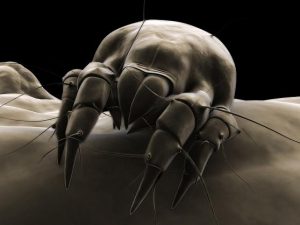Indoor Air Quality & Asthma

The dust mite is living on and with you!
It’s estimated that some 80% of asthmatics are allergic to dust mites. These tiny critters are too small to see but can be present in huge quantities in soft furnishings and, more worryingly, in our pillows and mattresses.
Their faeces can also float in the air when you shake your bedding or walk over a carpet where they have settled. The inhalation of this allergen can trigger an asthma attack.
Dust mites thrive in humid conditions, just the sort of environment you will have if your home is poorly ventilated.
Using a Positive Input Ventilation system will ensure that allergens, pollutants and condensation are removed from the home, creating a hostile environment for dust mites.
Clinical research has proven that this type of whole home ventilation can play a significant part in controlling dust mite allergens, and Olympic Construction has lots satisfied customers who claim significant relief from their condition after installation of a Drimaster or Flatmaster PIV product.
What are Dust Mites?
Dust Mites are related to ticks and spiders and they actually live on our household dust. Most of this dust is actually our skin or more specifically the dead skin that we are always shedding (We know, it’s a grim thought). This is one of the reasons they thrive in our bedding & mattresses, we lose a large amount of skin overnight and having such a plentiful supply of food on the doorstep (or pillow) is perfect for a Dust Mite.
In reality the Dust Mite can grow up to about 0.3 of a millimetre and luckily for us that’s too small to see with the naked eye. These creatures can be present in our soft furnishings and particularly bedding by the tens of thousands.
In fact, all houses contain Dust Mites. Some houses, however, contain huge numbers whilst others very few. This variation does not depend on cleanliness alone it is hugely influenced by the amount of moisture (or humidity)in the house: dry houses in very cold climates or on high mountains have very few mites, but houses in temperate climates and normal altitudes such as the majority of the general housing stock will have many more.
Having an allergy to Dust Mites can be the single biggest cause of an asthma attack. It is estimated by the medical profession that approx 80% of asthma sufferers will have an allergy to Dust Mites.
Life Cycle of Dust Mites
The life cycle of the Dust Mite is a 3-stage process: egg, larvae and adult. It takes about 2-3 weeks for the egg to hatch and for the larvae to grow into an adult. The adult will live for approximately a month afterwards
It is actually the droppings of the dust mite that cause the problems. They contain a residual enzyme that acts as the ‘trigger’ to cause the allergic reaction or asthma attack.
The droppings are between 10-20 microns in diameter, similar to the size of pollen grains. They are dry and susceptible to becoming statically charged. This means that if they are disturbed, by sweeping, hovering, shaking bedclothes etc they become airborne for a considerable period of time. Whilst they are airborne it is very easy for them to enter the bronchial system.
So why are moist houses so prone to Dust Mite infestations?
Very simply they generate the ideal conditions for the mites to thrive. They are less likely to reproduce in relative humidity levels below 65% although they can tolerate wide temperature variations (0-30 degrees C). At around 0 degrees they enter a comatose like state but are not killed at this temperature. The optimum temperature they like for breeding is around 20-25 degrees C, just about the same as most of us like to heat our homes.
Humidity however is a much more important factor and 65-75% relative humidity is ideal for the ‘mites’ to thrive. These are also the humidity levels that allow condensation dampness and mould growth problems to occur in homes or properties
What Difference will having a Nuaire Drimaster system installed make?
Understanding how this damaging and invasive creature thrives will help you appreciate why positive input ventilation can help to alleviate asthma attacks.
It can have three positive effects on the home.
Ø With this mode of ventilation the moisture laden air throughout the home is gently diluted and replaced with tempered, fresh, filtered and drier air from outside. The relative humidity levels will drop, so creating a humidity level and environment that is hostile to the Dust Mite.
Ø The effect of continuously replacing the air also reduces the amount of airborne droppings of the mite replacing it with filtered air from outside.
Ø The slight positive pressure in the house can make the airborne ‘droppings’ fall back to the ground more quickly, therefore making them less likely that you will breathe them in.
By adopting this method of ventilation and utilising barrier systems on pillows and mattresses (that prevent Dust Mites from entering and breeding within these ‘hot spots’) asthma attacks for those who suffer from the Dust Mite allergen can be significantly reduced. This in turn could reduce the amount of drugs needed and of course the distress of this unpleasant condition.


